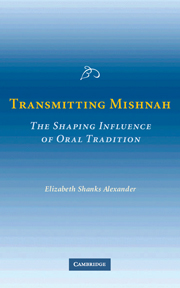2 - The Scripturalization of Mishnah
Published online by Cambridge University Press: 26 October 2009
Summary
A reader of m. Shevuot who encounters the text today takes for granted that this set of traditions is authoritative by virtue of its inclusion within the Mishnah. It is a generally accepted truth that the Mishnah occupies a privileged position as the first installment in the rabbinic canon. Historically, however, these traditions and formulations were not always uniquely privileged within the rabbinic corpus. As discussed in the last chapter, in the earliest phases of composition and transmission, notions of textual continuity existed that did not depend on fixed, linear sequences of words. In such circumstances, it is difficulty to imagine that any single formulation or arrangement of tradition stood out definitively among the others as original, authentic, or privileged. Traditions were performed, read, and studied in a variety of different versions and textual arrangements. By the end of the rabbinic period, however, the situation had changed. Though the verbal content of m. Shevuot was not safe from the vicissitudes of minor losses and corruptions in the course of transmission, its structure and content had largely been stabilized. Even more important, the received version of m. Shevuot came to be invested with authority. The emerging authority of the received text was reflected in the reading practices to which the text was now subjected. Many of the hermeneutical assumptions that rabbinic exegetes made about biblical scripture were now made with respect to the mishnaic materials.
Information
- Type
- Chapter
- Information
- Transmitting MishnahThe Shaping Influence of Oral Tradition, pp. 77 - 116Publisher: Cambridge University PressPrint publication year: 2006
